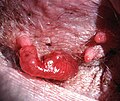Pouch (marsupial)
Pouch (Marsupial)
The pouch is a distinctive feature found in marsupials, a group of mammals that includes kangaroos, koalas, and opossums. It is a specialized skin fold located on the abdomen of female marsupials, which serves as a protective enclosure for their young, known as joeys. This unique adaptation sets marsupials apart from other mammals and plays a crucial role in their reproductive strategy.
Anatomy and Function
The pouch is formed by a fold of skin and muscle that extends from the abdomen of female marsupials. It is typically hairless and has a soft, warm lining that provides a comfortable environment for the developing young. The opening of the pouch faces towards the tail, allowing easy access for the joey to enter and exit.
The primary function of the pouch is to provide a safe and nurturing environment for the newborn marsupials. After a short gestation period, the underdeveloped joeys are born and crawl their way into the pouch, where they attach themselves to one of the mother's teats. Inside the pouch, the joeys continue their development, receiving nourishment and protection from their mother.
Evolutionary Significance
The evolution of the pouch in marsupials is believed to be an adaptation to their unique reproductive strategy. Unlike placental mammals, marsupials give birth to relatively undeveloped young. The pouch allows the joeys to continue their development in a protected environment, while still receiving the necessary nutrients from their mother's milk.
The pouch also offers advantages in terms of mobility and agility. By carrying their young in a pouch, marsupials are able to move more freely and efficiently, as their limbs are not burdened by the weight of the offspring. This is particularly advantageous for species that inhabit trees, such as koalas and tree kangaroos.
Diversity of Pouches
While the pouch is a defining characteristic of marsupials, its structure and position can vary among different species. In some marsupials, such as kangaroos and wallabies, the pouch is well-developed and prominent, extending horizontally across the abdomen. In others, like opossums, the pouch is less pronounced and opens vertically.
Additionally, the number of teats within the pouch can vary. Most marsupials have multiple teats, allowing them to nurse several joeys simultaneously. However, some species, such as the Tasmanian devil, have only four teats, limiting the number of offspring they can support at a time.
Conservation Status
The pouch, being an integral part of marsupial reproduction, is crucial for the survival of many marsupial species. However, habitat loss, climate change, and other human-induced factors have posed significant threats to marsupial populations worldwide. Conservation efforts are essential to protect these unique creatures and their specialized reproductive adaptations.
See Also
References
Transform your life with W8MD's budget GLP-1 injections from $125.
W8MD offers a medical weight loss program to lose weight in Philadelphia. Our physician-supervised medical weight loss provides:
- Most insurances accepted or discounted self-pay rates. We will obtain insurance prior authorizations if needed.
- Generic GLP1 weight loss injections from $125 for the starting dose.
- Also offer prescription weight loss medications including Phentermine, Qsymia, Diethylpropion, Contrave etc.
NYC weight loss doctor appointments
Start your NYC weight loss journey today at our NYC medical weight loss and Philadelphia medical weight loss clinics.
- Call 718-946-5500 to lose weight in NYC or for medical weight loss in Philadelphia 215-676-2334.
- Tags:NYC medical weight loss, Philadelphia lose weight Zepbound NYC, Budget GLP1 weight loss injections, Wegovy Philadelphia, Wegovy NYC, Philadelphia medical weight loss, Brookly weight loss and Wegovy NYC
|
WikiMD's Wellness Encyclopedia |
| Let Food Be Thy Medicine Medicine Thy Food - Hippocrates |
Medical Disclaimer: WikiMD is not a substitute for professional medical advice. The information on WikiMD is provided as an information resource only, may be incorrect, outdated or misleading, and is not to be used or relied on for any diagnostic or treatment purposes. Please consult your health care provider before making any healthcare decisions or for guidance about a specific medical condition. WikiMD expressly disclaims responsibility, and shall have no liability, for any damages, loss, injury, or liability whatsoever suffered as a result of your reliance on the information contained in this site. By visiting this site you agree to the foregoing terms and conditions, which may from time to time be changed or supplemented by WikiMD. If you do not agree to the foregoing terms and conditions, you should not enter or use this site. See full disclaimer.
Credits:Most images are courtesy of Wikimedia commons, and templates, categories Wikipedia, licensed under CC BY SA or similar.
Contributors: Prab R. Tumpati, MD


